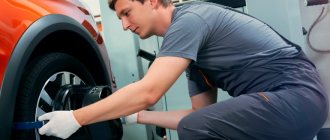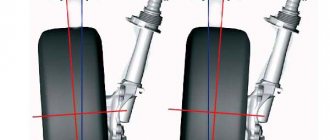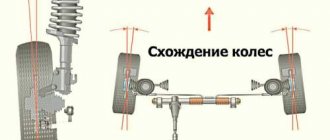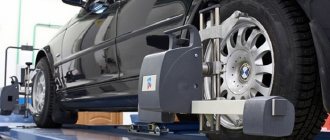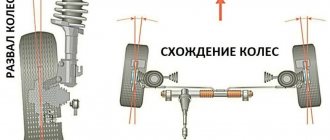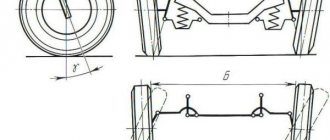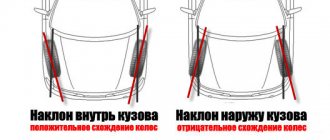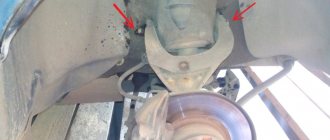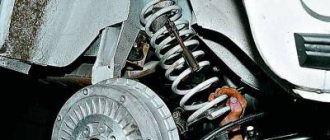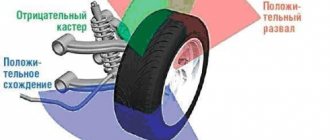The behavior of a car while driving is influenced by many conditions. These are the features of the depreciation system and the standard size of tires. But the main thing is the parameters of the installation angle of the rear and front wheels. The vehicle's stability on the road, handling, tire wear and even fuel consumption depend on them. Ideally, the wheels should be positioned strictly perpendicular to the road surface, but achieving such indicators is almost impossible. The position can change when turning, with a redistributing load, so the designers of the manufacturing plant immediately set several optimal geometry values for each car brand.
Types of tilt
In order for the car to be stable, controllable and safe when moving, the wheels (both front and rear) are installed according to certain parameters. The basis on which installers focus when making adjustments is the direction of movement, body parts and road surface.
Camber (Camber)
Represents the angle between the vertical vector and the wheel plane. Correctly aligned, it guarantees the correct position of the car wheels. When their upper area is inclined inward (towards the center of the machine), this indicates a negative value. If the car wheel is directed in the opposite direction (outward), it is positive. The photo below clearly shows the difference between the indicators.
When setting up, it is important to take into account that both tires need to be set as equally as possible. The deviation cannot be more than 30°.
When collecting information about what the camber angle of the front wheels should be, you should learn about other nuances.
- When a vehicle moves along a curved path, longitudinal tilt contributes to better stabilization. Under its influence, the car wheels try to take the desired position, which corresponds to moving in a straight line.
- Designers carry out calculations based on the characteristics of the vehicle body. In the factory configuration, the value is stable, but often when modifying the suspension (tuning), motorists independently adjust the values set by the manufacturer. This leads to the formation of collapse.
- Camber also forms when the vehicle roll changes, this is especially noticeable on trucks. When the truck is not loaded, camber is positive. Vehicles literally move on external tires. With a zero indicator, it is possible to achieve the least tire wear, which can significantly extend their service life. Negative characteristics also impart stability.
Toe-in (TOE)
The easiest way to study the wheel alignment angle is from photos and pictures: TOE is the inclination between the plane of the car wheel and the longitudinal axis of the vehicle. With proper adjustment of the indicator, it is possible to set the optimal wheel arrangement necessary for a comfortable ride.
The values are:
- positive (when mixing);
- negative (when diluted).
TOE ensures the correct position of the steered pair of wheels at different speeds and vehicle turns. Thanks to the toe-in, it is possible to compensate for small gaps and ensure the elasticity of the suspension. The indicators that are set by the manufacturer imply a parallel arrangement of the lines of the car wheels.
When the components of the suspension and vehicle control systems wear out, adjustment of the RS is necessary to increase the descent parameters. The main purpose of setting the tilt is to stabilize the rotation of the wheels while driving. As a result, TOE affects the car's handling and ability to drive straight. When the values differ from the specified ones, the vehicle begins to “wobble” along the road, the driver is forced to constantly correct the direction using the steering wheel.
When dealing with wheel alignment geometry, you should remember that exceeding the established values leads to rapid wear of the tires.
Signs of deviation from the norm:
- sawtooth damage on rubber;
- characteristic squeal when making a turn;
- excessive fuel consumption.
Our production
Cross slope (King pin)
This is the angle between the vertical line and the projection of the kingpin across the plane of the vehicle. If you set the wrong values, the car will become unstable and unstable on the road. Due to the constant change in the position of the wheels, it will not be easy to drive such a vehicle. And if there is a large difference between the indicators of the angle of inclination of the axis of rotation (TAA) of the left and right sides, the car will drift.
The LOP is formed between the imaginary vertical and the MacPherson suspension, which is directed inward (when viewed from the front). Typically this level is set by the manufacturer and cannot be adjusted. However, some manufacturers use a change in the NOP angle to simplify camber correction. This angle is always positive.
By adjusting the LOP, you can minimize the impact of surface impacts and reduce the risk of loss of steering control after hard braking.
Setting incorrect values can also lead to:
- reduced steering stabilization;
- premature wear of components of the suspension unit;
- inability to move straight over rough terrain.
Kingpin caster (CASTER)
When studying methods for installing alignment and camber, you should remember that Caster is measured in degrees. The indicator is presented as an angle in the axial plane of the vehicle, located between the vertical and the line connecting the central turning zones. The straight line passes through the ball joints along the suspension arms located above and below, if you have a standard double-wishbone system in front of you. Or along the upper and lower mounting points of the shock absorber strut, in the case of a MacPherson unit or the longitudinal axis of the vehicle. The Caster value can be negative or positive.
When driving in a straight line, correct adjustment of the front wheels allows them to maintain their established position. If the parameters are violated, the car will be pulled to the side, a characteristic squeal will appear when the car turns, and additional efforts will have to be made when performing maneuvers to the right and left.
When making adjustments, it is important to know that body defects usually cause the CASTER to change unevenly. Such a difference between the tilt of the kingpin on the right and on the left most often entails the vehicle moving off the trajectory, even if the other angles are adjusted as necessary.
It is Caster that allows the steering system to self-center. The correct setting directly affects the ability to turn easily when coasting, accelerating or braking. So, for sports cars on slippery and uneven road surfaces, a steeper longitudinal slope (vertical) would be optimal. On smooth roads with good grip, a gentle (smooth) angle is more suitable.
Running shoulder (SCRUB RADIUS)
It is the gap between the point where the support and the central plane of rotation of the wheel intersect, and the place where the axis of rotation coincides with it. The value can be positive, negative or zero. SR is determined by the transverse angle, camber and offset of the disk.
If there is a negative indicator, the wheel tries to move in the direction opposite to the turn, and the steering wheel pulls to the starting position. Zero ensures that there is no extraneous influence of forces on the control system if tire damage occurs or the car has to brake sharply.
The parameters depend not only on the design features of the suspension, but also on the tires themselves. When the value is other than zero, the settings act as a lever, affecting the components of the suspension assembly and steering.
A positive shoulder can lead to disruption of the course and stability of the vehicle due to an increase in the drag force of any of the wheels.
When setting the characteristics to zero (or a value close to it), remember that in this situation the plane of rotation shifts to the outer part of the treads, which leads to problems with driving the car. At the slightest unevenness of the road surface, the steering wheel will be torn out of your hands. In addition, wheel bearing damage will seriously increase.
Questions on the topic
Filter:AllOpenSolvedClosedWaiting for response
Why does the car start to drive on the highway above 60 km? Answered by User answered 8 months ago
23 views 1 answer. 0 vote.
Strongly eats the inside of the front wheels of the Honda Accord VII Answered by User Answered 8 months ago
26 views 1 answer. 0 vote.
There is not enough front wheel camber adjustment on the Volkswagen Touareg, what are the reasons? Answered by User answered 8 months ago
24 views 1 answer. 0 vote.
What should the wheel alignment angles be on a Toyota Opa? Answered by User answered 8 months ago
25 views 1 answer. 0 vote.
What are the wheel alignment parameters on the Chevrolet Viva? Answered by User answered 8 months ago
25 views 1 answer. 0 vote.
Ask a Question
Front axle wheel alignment adjustment parameters: changing values
The values may change when system components wear out and old parts are replaced with new ones. All tips and rods that act as a connecting link between the steering column, the mechanism itself and the wheels have a threaded connection. It is this that makes it possible to reduce or increase the length of messages to correct the toe angle.
The toe-in of the front and rear wheels is adjustable on all types of units. The exception is the axle or rear beam. Camber adjustment is more often found on axial suspension units with lower and upper link centers.
In addition, it is not possible to adjust the parameters of both axes on all brands of cars. This will not be possible on models with independent MacPherson strut suspension (with a number of exceptions).
Dynamic stands
The principle of operation of dynamic stands is as follows. The wheels of a car, when driving through the stand area or rotating on its rollers, create a lateral force when the tires come into contact with the supporting surface, which is recorded by special devices. Based on the type of support-receiving devices, dynamic stands are divided into roller (drum) and platform. The main disadvantage of dynamic stands is the low measurement accuracy. With their help, you can only comprehensively evaluate the installation of wheels, which makes it difficult to determine element-by-element faults.
When to adjust and is it worth it?
Wear of parts is a natural process that cannot be prevented. When components are deformed, the angle values change, which is why they have to be adjusted and the correct wheel alignment must be installed.
Typically, the need for unscheduled intervention arises after a vehicle hits various obstacles, or gets a wheel into a hole or an open hatch. The same thing happens after accidents in which the body part was damaged.
If after the incident the car’s behavior on the road has changed (it begins to pull to the side, while driving the steering wheel is not in the central position, when exiting a turn it does not return to its original position, the tires wear unevenly, a characteristic squeal is heard, etc.), do not hesitate - contact service station specialists for help. Their assistance will also be needed after replacing components of the suspension and steering system.
Minus camber
It would seem, why deviate from the manufacturer’s recommendations and install negative camber if the handling will change, and not necessarily for the better? In fact, handling improves slightly - it becomes possible to easily enter a turn even at high speed. In addition, skidding and rollover can be avoided. Most often, drivers of sports cars resort to this modification. For civilian driving, such tuning is useless - in the city the speeds are different.
Where is the best place to set up?
We advise you to trust the care of your car to trusted salons or familiar specialists. When choosing a company, rely on personal recommendations, online reviews and service station ratings to find a really good place.
To diagnose the general condition of a vehicle, a competent technician will only need a lift and a measuring device. If you wish and have knowledge in the field of truck maintenance, you can evaluate the scope of work yourself. But if you decide to delegate this responsibility to a specialist, he will cope with the task more efficiently and will be able to not only diagnose the problem, but also fix the problem.
When it comes to a thorough inspection and elimination of serious problems, it’s definitely not worth saving on visiting a service station. Salon technicians have appropriate equipment (such as a 3D stand), consumables and assistants, which helps them deal with breakdowns faster than amateur motorists.
Adjustment features
Wheel alignment can only be done if the chassis and control system are in good working order. Before repairing, the technician must make sure of this. Namely: place the vehicle on a lift, inspect the tires, supports, springs, steering wheel, etc. At the same moment, the tire pressure is checked.
If serious damage or play is detected, the technician must refuse to adjust the tilt parameters. All existing defects must first be eliminated.
If there are no deviations, the machine is placed on a horizontal platform and loaded, following the manufacturer’s recommendations, since it is he who usually indicates the optimal settings taking into account the load. Therefore, making adjustments on an “empty” car is already a violation. In order for the suspension elements to fall into place (assume working condition), apply forceful pressure to the front and rear of the vehicle.
Regardless of the stand at which the adjustment is carried out, the craftsmen compensate for the disc runout in order to avoid serious violations in the measurements.
conclusions
Checking and adjusting wheel alignment is an important and necessary procedure. It is even more important in our conditions, with our roads and their condition. By setting the correct wheel alignment angles, you can increase the vehicle's handling, stability and stability while driving. Also, thanks to the correct wheel alignment angles, tire wear and fuel consumption are reduced.
Related publications
- How tire pressure sensors work
- Forged wheels: what are they and how do they differ from cast wheels?
- Pros and cons of low profile tires
- Pros and cons of all-season tires
Leave a review
Cancel reply
When and how to adjust the toe angle of the front wheels
During operation, the tilt parameters change. The UCC should be checked and configured:
- after repair work, replacement of suspension parts;
- when installing (dismantling) gaskets to increase ground clearance;
- when excessive or uneven tire wear appears;
- The steering wheel stops returning to its original position when driving straight or when turning.
Motorists adjust wheel alignment at service stations or in the garage. When planning to make the adjustment yourself, it is important to understand that this requires not only special tools and suitable space, but also the appropriate skills. Therefore, in their absence, it is better to seek help from specialists.
When can you change the acceptable value?
When setting the zero deflection, the service life of the tires will be maximum. It should be installed if:
- the car is used primarily for driving in a straight line;
- by car they transport cargo two (or more) times lighter than the maximum norm;
- the vehicle has new springs, tie rods, and silent blocks;
- the motorist drives at an acceptable speed, operates the vehicle calmly and carefully;
- mostly you have to drive on good, smooth roads;
- the car is operated on a dirt or sandy surface;
- It is possible to check and configure the UCM at any time.
What is wheel geometry?
Wheel geometry is a common term that in everyday life among car enthusiasts and at service stations is called “wheel alignment”.
This setting affects the following machine parameters:
- Controllability;
- Tire wear rate;
- Sustainability.
Adjusting the wheel alignment angle is mandatory for all cars, and the work itself must be performed by specialists using special equipment.
What are the dangers of incorrectly setting wheel toe and camber angles?
If the tilt parameters are set incorrectly, the car owner will face a lot of unpleasant moments. Among them:
- rapid tire wear;
- systematic damage to oil seals, bearings, steering fingers;
- increased fatigue on the road, when the car has to be leveled every now and then.
In addition, a car with inadequate performance may skid when turning, it will lose stability and change direction when braking. As a result, not only will your truck break down more often, but your risk of getting into an accident will also increase.
Flaws
We looked at what negative camber produces. Now we need to talk about the shortcomings. If you have no sporting ambitions, then it is better to refuse such tuning.
One of the serious disadvantages is increased wear on the inside of the tire. If you need to quickly accelerate or brake, then the efficiency of both acceleration and braking will be reduced - the contact area of the wheel with the road has decreased. And finally, when driving on bad roads, the car may move to the side.
The most unpleasant thing is tire wear. This will happen if the negative camber is more than 1 degree. The higher this angle is, the faster the tires will wear out. Racers can afford to change tires even after just a few laps. The average driver often cannot afford this.
How installation angles affect handling
In order to consider the characteristics of the vehicle depending on toe-in and camber, relevant research and tests were carried out with the participation of the VAZ-2114.
Negative Caster
Caster was set to the maximum minus value. The position of the front pair of wheels is shifted back. This picture can most often be seen on a very old car.
After making adjustments, the vehicle began to respond well to steering inputs. But at the same time it turned out to be too easy, the car began to “drive”, and instability appeared. To drive the VAZ-2114, the driver had to make a lot of effort and steer while turning. It is almost impossible to control the behavior of vehicles at high speed.
Correct installation
When the caster angle is set to normal-plus, the wheel alignment is set to zero. In this situation, the VAZ-2114 behaved completely differently: the vehicle demonstrated good stability when driving straight. Management has become easy and comfortable.
Drift
This wheel alignment angle is especially relevant for drifting. The car grips the road better. For drift enthusiasts, the camber should be between -0.5 and -5.5 degrees.
Also, negative camber can be considered optimal for participants in circuit racing. In this case, the negative camber angle of the front axle should be greater than that of the rear axle. This ensures better traction, sharper and more responsive steering.
